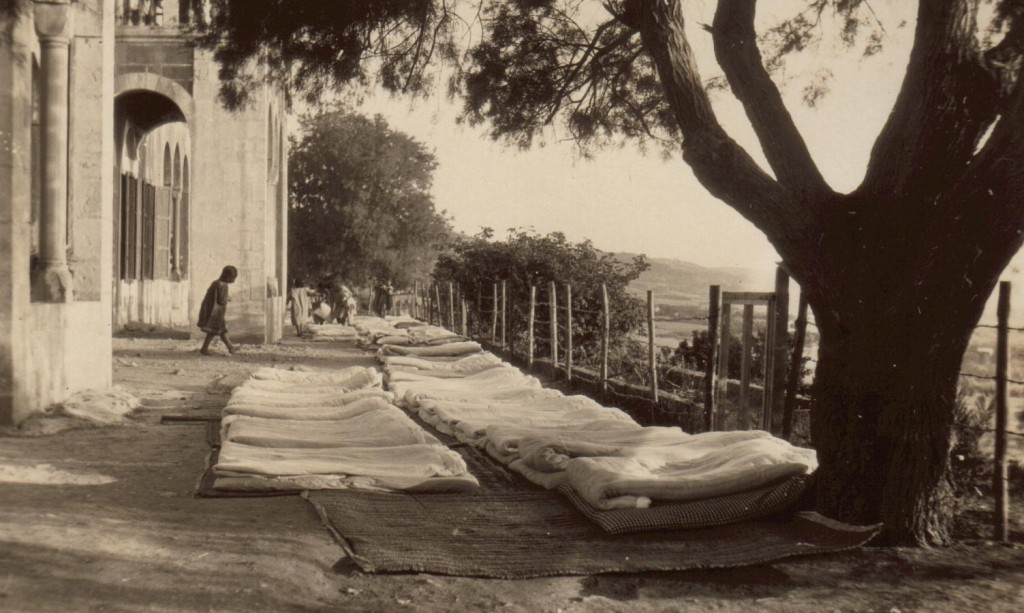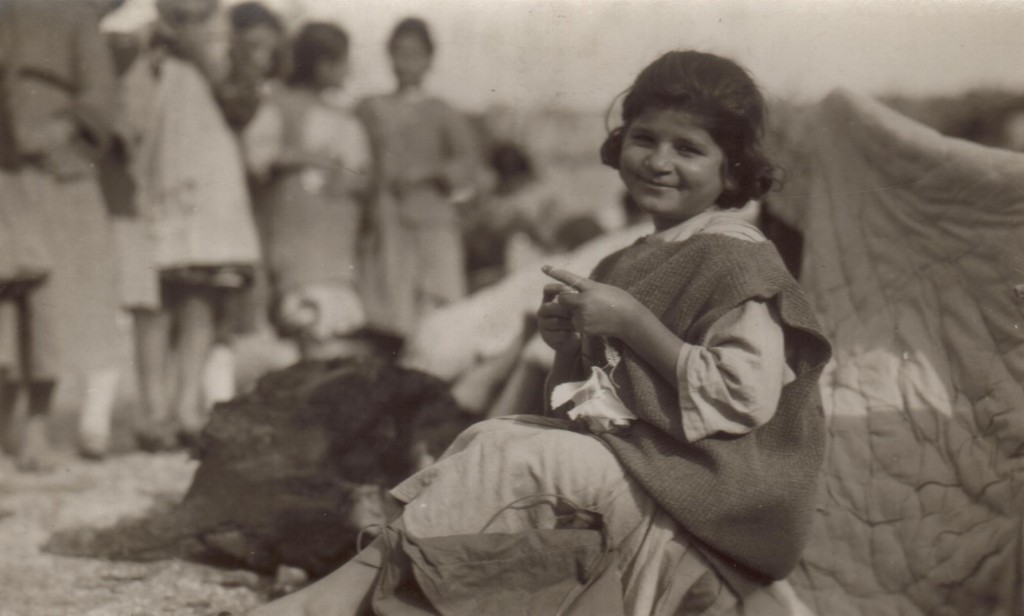Vacation at the Birds’ Nest (Part 2): A Day in the Life
Near East Relief worker Nellie Miller Mann loved to visit the little “birdies” at the Birds’ Nest Orphanage. David W. Mann published his mother’s writings and photographs from her time with Near East Relief in the book Letters From Syria, 1921-1923: A Response to the Armenian Tragedy, Including Stories, Travel and Reports in 2013.
This Dispatch series is excerpted from Nellie’s letters. The text is reproduced with the kind permission of David W. Mann. You can read Part 1 here.

Tidy outdoor beds at the Birds' Nest orphanage, c. 1923. Fresh air was thought to promote good health in the orphans.

MONDAY, MAY 21, 1923
Miss Yacobsen and I went to hear the children at their morning prayers. One of the teachers read a portion from the Armenian Bible to the girls all squatted cross-legged on mats on the ground. Throughout the quite lengthy prayer and during the silent period after the audible prayer every child’s eyes were closed tight. After the service, all the children passed before Miss Yacobsen for inspection. She looked over each one to see that her dress was clean and tidy and her hair neat before going to school. Although Miss Yacobsen is a very loving mother, she is also very strict. She loves to see her girls clean and tidy, but many of the girls have become so used to being filthy and uncouth that it is extremely difficult for them to learn to keep themselves clean.
The children rise at five and dress in their work clothes. Some of them lay the mats and tin bowls and spoons in rows out in the yard for breakfast. Others sweep the huge court yard with palm branches, others distribute the food into the dishes; some make the beds, and some scrub the floors, some wash and dress the babies; and various other jobs so that everyone is busy. If they hurry through with their work they have a play time before it is time to comb and dress for school.
After breakfast the nurse holds a little clinic out in the yard behind the house, where all the children who have wounds or scratches come to have a daub of iodine or a bandage “to make it well.” To see seventy-five little tots squatted around the room singing and playing kindergarten games is a soul-thrilling sight. And they are not bashful; but animated, responsive and full of initiative. The smallest ones take their part with the older ones, suggesting songs and games, leading in some of the exercises, singing little solos and reciting verses. I was frankly surprised.
Nellie Miller and children in the garden at the Bird's Nest, c. 1923. The children loved to help with the plants and flowers.
Every afternoon, after school is over, Miss Yacobsen takes a few of the children out into the beautiful garden beside the house, that they may play about among the flowers. They love to help water the plants and thus learn to appreciate Nature.
The garden is a wonder – with almost every variety of flower and plant imaginable – roses, violets, geraniums, daisies, myrtle, poppies, periwinkles, snapdragons, honeysuckles, oleanders (white and red), scarlet sage, mock-orange, flowering pomegranate trees, hollyhocks and bushes of sweet williams, palms, evergreens, century plants, one with a bud on a tall stem about ten feet high and about four inches in diameter, banyan trees probably imported from India, cactus, and besides these many other oriental trees and shrubs the names of which I do not know.
In the center of all this is a lovely fountain where hundreds of tadpoles and polliwogs breed among the crude stone arches and nibble at the jack-olander blossoms which fall from the overhanging tree, and where hoarse voiced frogs give their nightly serenade. Here in the garden an occasional bird stops to twitter and chirp.

Young girl sewing, c. 1923.
TUESDAY, MAY 22
The morning is bright and full of noise. Again I visit the kindergarten where the center of interest lies for me. During recess Miss Yacobsen cut some of the little children’s hair, and they thought it was such fun that all the babies wanted their’s cut too. About four o’clock in the afternoon a car drove into the courtyard. Mr. Blatchford was bringing Dr. L. [probably Dr. Esther Lovejoy from American Women’s Hospitals] to visit the orphanage. She was a charming cheery woman with a keen interest in everything she saw. She had been in the orphanages in Greece and Palestine; but of all the orphanages of the N.E.R. which she visited she said she had seen none which met with her entire approval as did the Birdsnest.
She was glad to see the children dressed in bright gingham; for she wondered why it was necessary for orphans to dress in dull drabs and wear dull expressionless faces. She visited the kindergarten where the children were romping, shouting and laughing. She was delighted with their songs and folk dances; and said she would go home to New York with a more hopeful story because she had seen these little tots. When she asked Miss Yacobsen how many deaths she had had during the year, and Miss Yacobsen said “none!”, she could scarcely believe it. But Miss Yacobsen said, “I am a trained nurse. When the children came down from Harpoot many of them were weak and sick with fever, but we nursed them back to health.”
Mr. Beach who also accompanied the group, found many of the Talas children, who recognized their director and eagerly came forward to him. One little girl he found had treasured in her pocket the cover of an Armenian Hymn Book which she had brought with her from Talas. It had only one leaf attached to each cover; the one bore the words of the Hymn “Praise the Lord for He is Gracious”; the other bore the Index. A mere shell it was, but to her a gem, because it represented to her a possession of her very own, a relic from her own home and a song of praise to her Protector.
